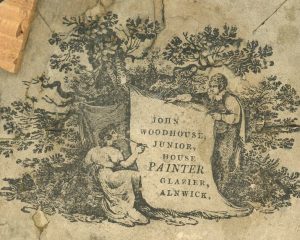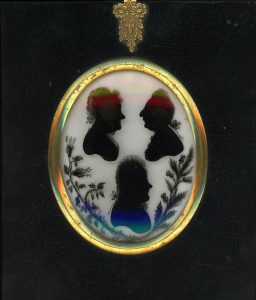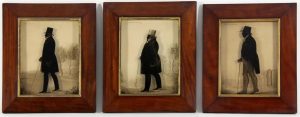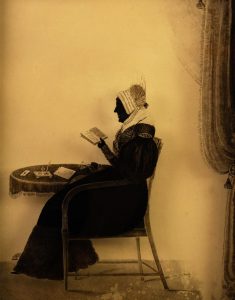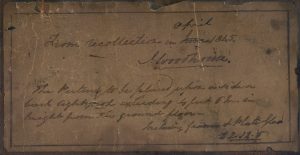John Woodhouse, Tradesman
John Woodhouse is best known for his full-length profiles reverse painted on flat glass with ethereal scenic backgrounds set in deep wooden frames. Many of these were painted from memory following the death of old friends. But portrait painting was not always John’s main occupation as proved by the tagline ‘House Painter, Glazier’ on his only printed trade label.
John Woodhouse was born around 1773 in Northumberland to John and Appalina/Appaline (née Elliot). Born in 1750/51, John Senior was apprenticed in 1763 to Thomas Harrison, a plumber in Alnwick. He subsequently moved to London briefly, as an advert he placed in the Newcastle Chronicle (1st June 1771) ‘begs leave to acquaint his Friends and the Public, that he just arrived from London, and has opened Shop at Alnwick’ as a plumber, glazier and tinman. Whilst plumbing was his main line, he was also proficient at making engines and pumps out of brass and lead. Records show that he married Appalina that same year so perhaps she was the lure that brought him back to Alnwick.
Several children were born over the next few years. The family were non-Conformist. Individual birth records have not been traced and several children were baptised at the same time: the boys, John and Thomas, in May 1779; the girls, Appaline, Maria, Elizabeth and Ann, in January 1789.
John Sr. hired various apprentices but the business struggled as in 1794 he found himself in Morpeth Prison for debt. His younger son Thomas followed his father into plumbing being consistently listed in the trade directories as a Tin-Plate Worker and Plumber in Alnwick. John Jr on the other hand was of a more artistic bent and traded as a house painter and glazier. The Newcastle Courant records the death of John Sr. in 1824 at the age of 74. At this point his son dropped the suffix ‘Junior’.
The earliest known record of John’s trade as a ‘Painter & Glazier, Stainer &c.’ is a flyer dated 14 April 1817 –
The season for Painting having commenced, J.W. respectfully solicits the support of his Friends and the Public in general; and takes the opportunity of returning his grateful thanks for the many favours conferred upon him since his commencement in Business.
N.B. An Apprentice Wanted
A further flyer dated 18 January 1819 adds Gilding to his list of trades and informs the public that he has ‘resumed his situation’, suggesting there had been an hiatus of some sort.
Unlike his brother, John did not stay in Alnwick but from 1821 onwards moved about within Northumberland. This may have been for economic reasons as Alnwick was a small town and there may not have been enough work for him or it may have been for personal reasons as it is known from probate records that he was a widower when he died. A John Woodhouse married Mary Edwards at Christ Church Tynemouth in March 1796 so a move south may have been at the behest of his wife.
Although access to local trade directories has been limited to four editions, they, coupled with other resources, provide a rough timeline to Woodhouse’s movements:
- 1821-23 – Painter, Bondgate Street, Alnwick
- 1822 – dated silhouette taken in Newcastle
- 1827-29 – Painter in Shade, 9 Blackett Street, Newcastle
- Pigot’s 1829 – Portrait Painter, 9 Blackett Street, Newcastle
- Pigot’s 1834 – Portrait Painter, Lower Pearson Street, North Shields
- May 1835 – Newcastle Courant notice to creditors of ‘John Woodhouse late of Newcastle upon Tyne, painter’
- 1841 Census – living in Back Street, Tynemouth along with 53-year old Anna Woodhouse who may have been his sister or his wife
- 1850 – Newcastle Courant announces his death at Alnwick ‘on 27th [May], aged 77, Mr John Woodhouse, artist, formerly of Newcastle’
What prompted John Woodhouse to paint silhouettes is debatable. Being a glazier he had ready access to suitable glass and likely worked on stained glass projects; being a house painter he had ready access to paint. Perhaps the loss of a close friend prompted him to capture an image as a lasting tribute. His earliest known profile is dated 1821 though the majority of his work was completed during the 1830s and 1840s. Unlike other silhouette and portrait artists, Woodhouse did not paint from live sittings but from recollection. A contemporary account praised his remarkable ‘faculty of retaining the exact forms of objects for a length of time after he has seen them’.1
Woodhouse’s surviving body of work is small. Amongst his named sitters were: Thomas Fell, Tynemouth (died 183*), Mr Thorburn (died 1833), Charles & Samuel Dixon, boot & shoe makers, Newcastle upon Tyne (1840), Walter Dixon, corn merchant & miller, Archibald Reed, six times Mayor of Newcastle, Rev Christopher Reed, vicar of Christ Church Tynemouth (1842), Matthew Plummer Newcastle upon Tyne (1842), Robert Ridley, supervisor of excise (died 1842), John Charlton (on horseback), Dr Thomas Masterman Winterbottom (dated 1821; d.1859), & Col. Reid.
The majority of his sitters were middle-aged and elderly men mostly painted ‘from recollection’, some posthumously. He did though paint the occasional mature lady but no examples of children are recorded.
Only one example of Woodhouse’s printed label has so far been recorded. His full-length work is usually backed with a hand-written label that includes hanging instructions for optimal positioning of the work –
… to be placed upon a back or side light not exceeding 4 ft 6 in. in height from the ground floor
This particular label also priced the silhouette including the frame at £2 12s 6d.
Family details are sparse for John Woodhouse. His father died in February 1824, his mother in May 1826. Of his siblings Appaline died in 1800 and was buried in Corbridge suggesting she had left home; Thomas retired from plumbing to join his widowed sister as an innkeeper until his death in 1843; in 1831 Maria married a local widower George Hindmarsh, a boot and shoemaker, who subsequently took over the running of The George Inn in Alnwick until his death in 1838 when Maria took over as a ‘spirit-merchant’ until her own death in 1844. No trace of John’s wife’s death has been discovered nor any records of children born to the couple. John himself died of “water on the chest” back home at Bondgate, Alnwick on 27 August 1850.
Footnote
1. Eneas Mackenzie, ‘Institutions for the Arts & Amusement: The Northumberland Institution’, in Historical Account of Newcastle-Upon-Tyne Including the Borough of Gateshead (Newcastle-upon-Tyne, 1827), pp. 575-590. British History Online http://www.british-history.ac.uk/no-series/newcastle-historical-account/pp575-590 [accessed 31 July 2021].
